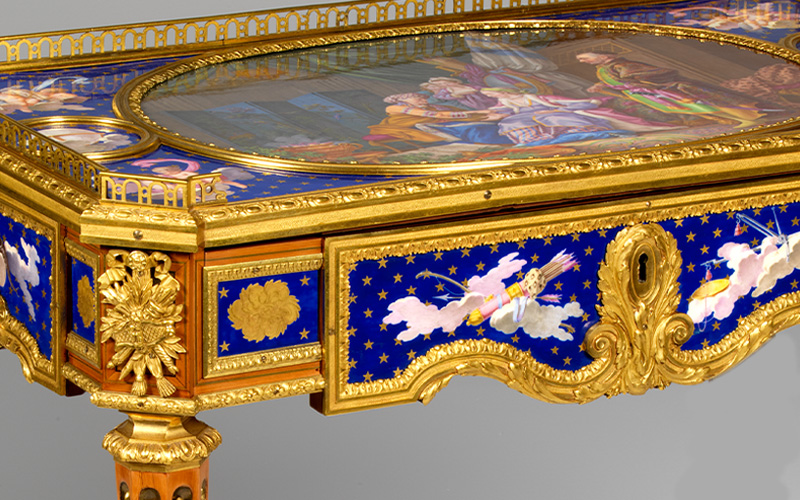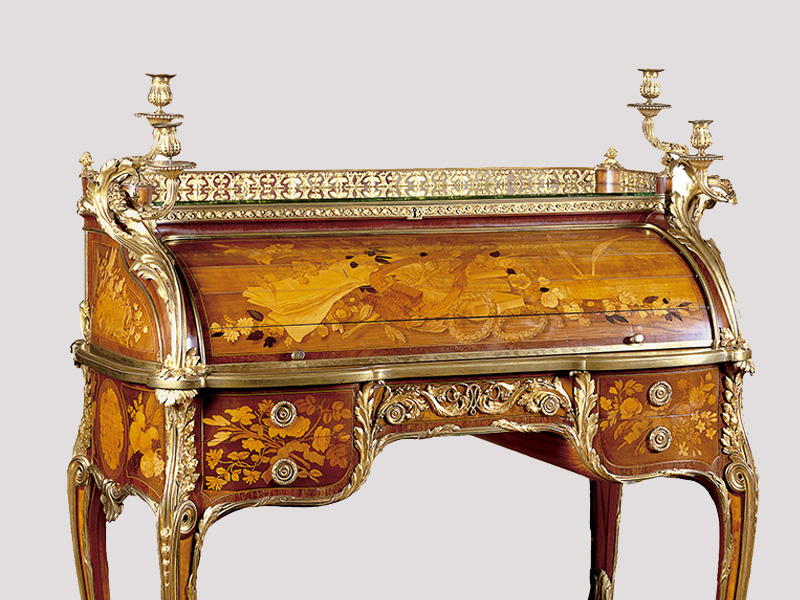
The Golden Age of French Furniture
From the Workshop to the Palace
Event Slider
Date
- Closed on Tuesday
Location
Founder’s Collection – Lower Gallery Av. de Berna, 45A, Lisbon Maximum capactity: 25 visitorsKnown as the Golden Age of French furniture, the 18th century witnessed many transformations in the field, having reached an unparalleled level of technical and artistic quality. This was facilitated by the favourable conditions present at the time.
The exhibition features several emblematic items of furniture produced during this era, which now form part of the Founder’s Collection, including Jean-Henri Riesener’s roll-top desk, as well as significant national and international loans from the Museu Nacional de Arte Antiga and the Musée des Arts Décoratifs, among others.
It aims to explore the various phases involved in producing these items, from the raw material, wood, to the delicate, extravagant furniture created for royal palaces, revealing the secrets behind their creation: the artisans that conceived them, the preferred materials and the techniques and tools used. Collaboration with the Fundação Ricardo do Espírito Santo Silva was essential, providing information on materials and technical details to give the exhibition a more practical component.
From the end of the 17th century, traditions became more relaxed, influencing many aspects of society such as the way in which people interacted and lived together. These behavioural changes were reflected in the interior settings of the era. The taste for comfort, combined with a quest for sophistication, took on increasing importance in palace life.
Furniture accompanied societal transformation, adapting itself to new emerging needs. In order to meet the requirements of an enlightened, sophisticated clientèle, always on the lookout for new trends, cabinet-makers and ébénistes began to innovate in terms of the techniques they used. Furniture was now designed with a specific purpose in mind, although its aesthetic appearance was also taken into consideration. Whether they were architects, decorators or even skilled artisans, furniture designers attempted to meet the needs of their customers, heralding the dawn of modern design.
Curators: Clara Serra

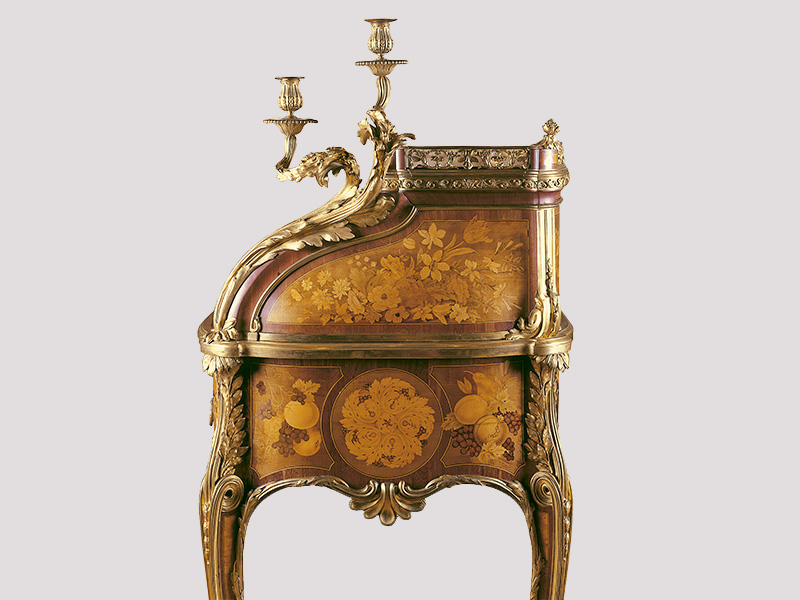
VISITA 360º
Topics

André-Jacob Roubo

The Design – Where It All Begins

Tools and Joints

The Wood

Marquetry and Ébénisterie

Gilt Bronzes

An 18th-Century Workshop

18th- Century Furniture
-
André-Jacob Roubo

André-Jacob Roubo. L’Art du Menuisier en Meubles (detail). Paris, 1769– 1775. Founder’s Collection 
André-Jacob Roubo. L’Art du Menuisier en Meubles (detail). Paris, 1769– 1775. Founder’s Collection 
André-Jacob Roubo. L’Art du Menuisier en Meubles (detail). Paris, 1769– 1775. Founder’s Collection In this exhibition we highlight the work L’Art du Menuisier by André-Jacob Roubo (1739-1791), published in 1774. This treatise on cabinet-making and ébénisterie remains an authoritative work for researchers of 18th-century French furniture. Roubo was born in Paris to a family of cabinet-makers. Besides practising his profession, Roubo was a theoretician as well as a practitioner in the field of cabinet-making. As was the custom at that time, he began to learn the trade at a very young age in his father’s workshop. Although he did not obtain a good education, he always took an interest in learning and taught himself several subjects including mathematics and drawing.
-
-
The Design – Where It All Begins

André-Jacob Roubo. L’Art du Menuisier en Meubles (detail). Paris, 1769– 1775. Founder’s Collection 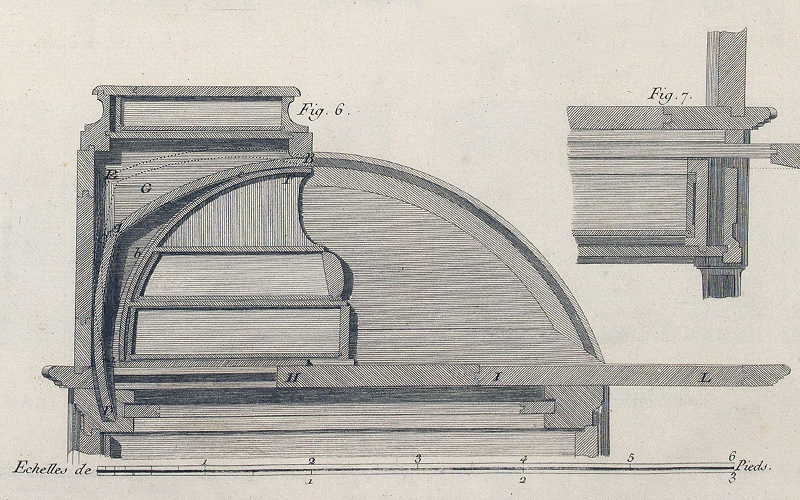
André-Jacob Roubo. L’Art du Menuisier en Meubles (detail). Paris, 1769– 1775. Founder’s Collection 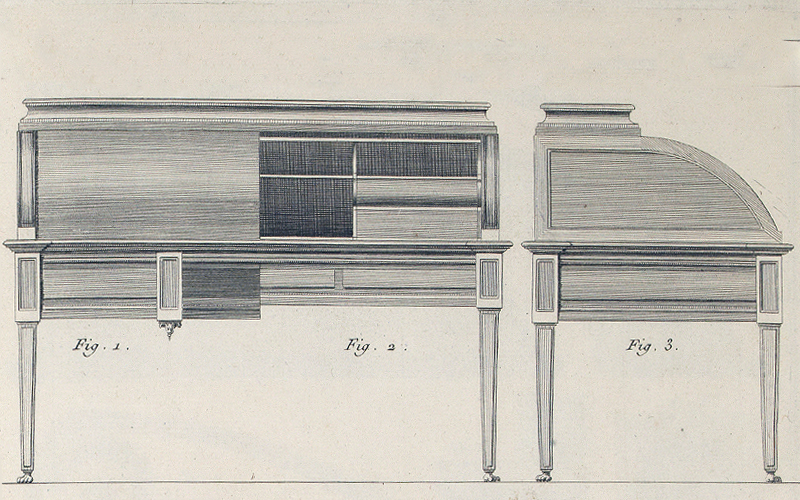
André-Jacob Roubo. L’Art du Menuisier en Meubles (detail). Paris, 1769– 1775. Founder’s Collection The starting point for any item of furniture is the design: this is where the process begins. Architects and decorators, artists who designed and sketched out the ornaments, were responsible for decorating interior spaces, including designing the furniture and textiles. The rough sketches of the furniture would later be transformed into executable or technical drawings drawn to scale with measurements. This demanding task was carried out by the cabinet-makers, who possessed the technical knowledge required. Unfortunately, very few of these drawings have survived and those which do exist rarely correspond to the items of furniture known to us.
-
-
Tools and Joints
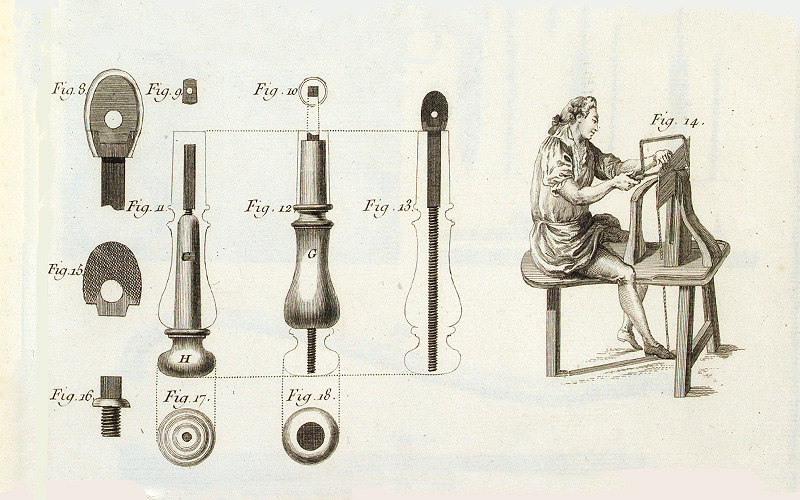
André-Jacob Roubo. L’Art du Menuisier en Meubles (detail). Paris, 1769– 1775. Founder’s Collection 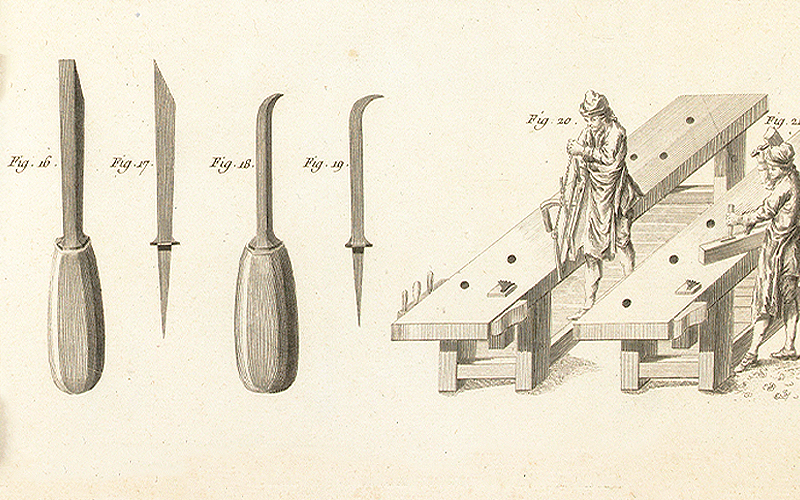
André-Jacob Roubo. L’Art du Menuisier en Meubles (detail). Paris, 1769– 1775. Founder’s Collection 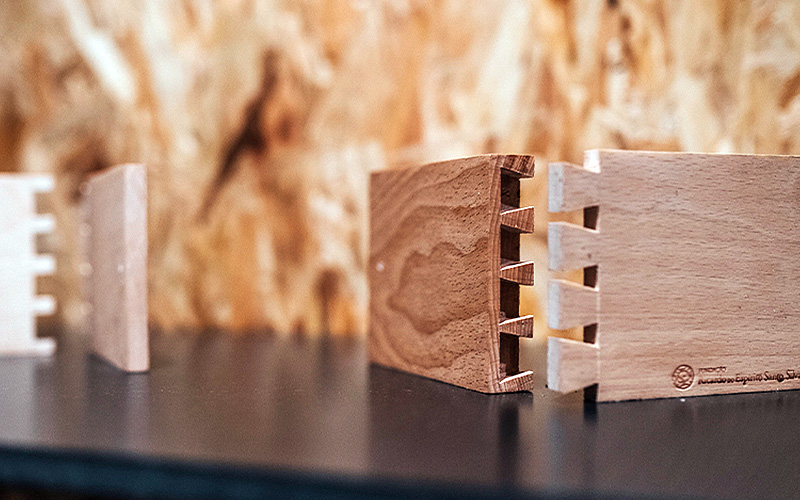
View of the exhibition. Photo © Pedro Pina An essential part of the structure of an item of furniture are the different types of joints. These hold the different parts of the furniture together. In 18th-century furniture, joints were used rather than nails. Joints make the furniture more robust. There are different types of joints, which vary according to the purpose for which they are intended.
The tools used in the 18th century were reproduced in the book L’Art du Menuisier by André-Jacob Roubo. Most of them are familiar to us. The tools in the exhibition are from the Ricardo do Espírito Santo Silva Foundation and are still used today.
-
-
The Wood
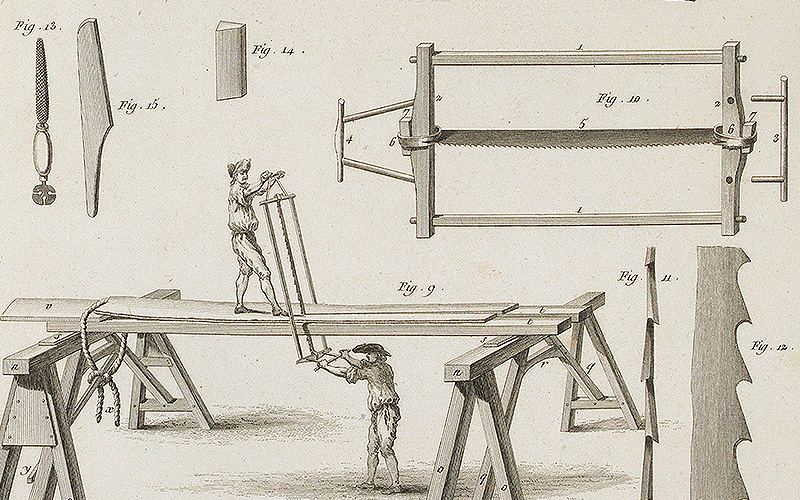
André-Jacob Roubo. L’Art du Menuisier en Meubles (detail). Paris, 1769– 1775. Founder’s Collection 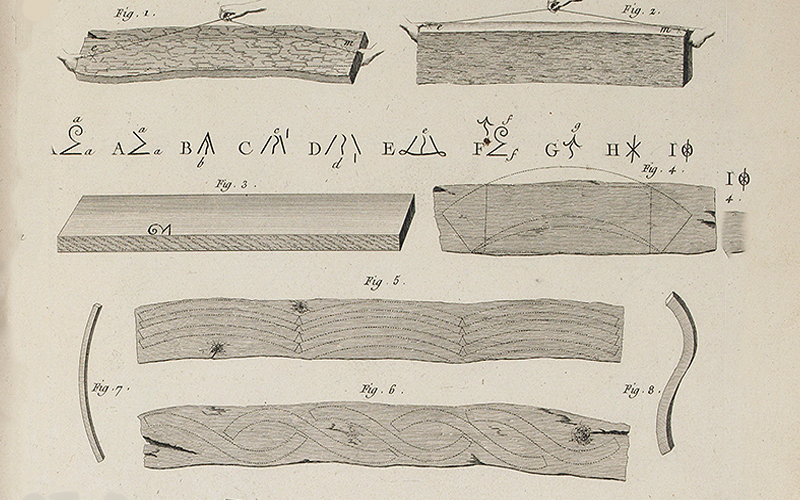
André-Jacob Roubo. L’Art du Menuisier en Meubles (detail). Paris, 1769– 1775. Founder’s Collection 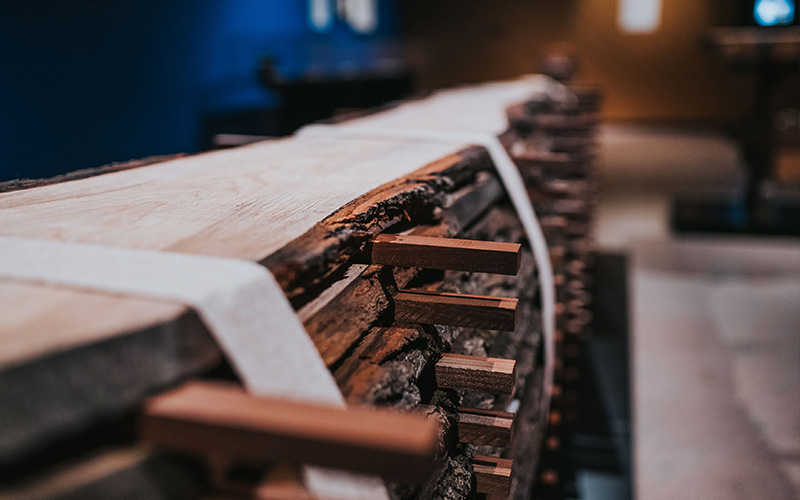
View of the exhibition. Photo © Pedro Pina Wood is the main raw material used in furniture production. In French furniture, wood is used in two ways: for the structure and for the veneer work applied by ébénistes. The structure was usually made from autochthonous woods taken from trees growing on French soil, as these were more widely available, cheaper, robust and durable. Oak was one of the most commonly used types of wood in furniture production.
With the development of furniture made by ébénistes, which reached its peak in the 18th century, solid wood was no longer used in high-quality furniture. The use of veneer and marquetry prompted exotic woods, brought from the Indies, to take on a more prominent role.
These woods derived from warmer parts of the planet and had unique characteristics (colour, texture, among others) which made them very different from European woods.
-
-
Marquetry and Ébénisterie
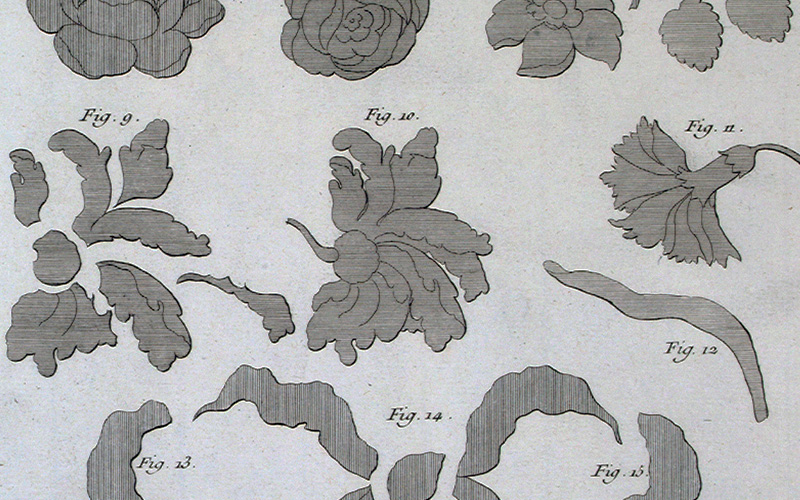
André-Jacob Roubo. L’Art du Menuisier en Meubles (detail). Paris, 1769– 1775. Founder’s Collection 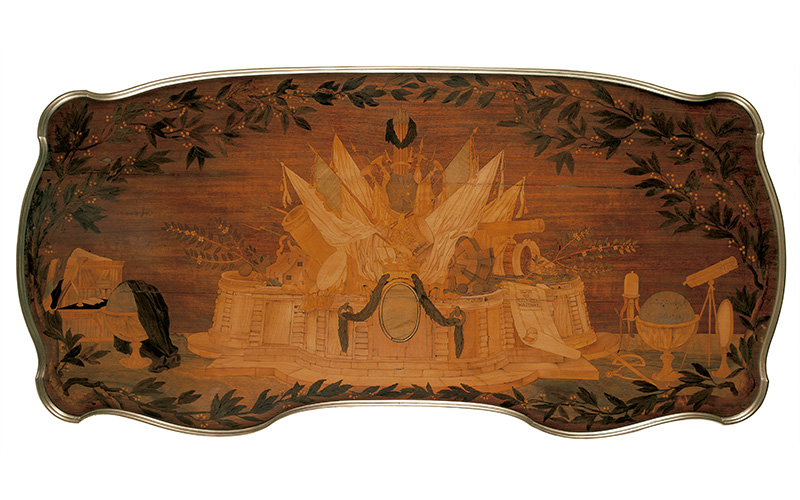
Jean-François Oeben. Mechanical table (detail). Paris, c. 176. Oak, elm, limewood and exotic woods; gilt bronze, velvet, mirror. Founder’s Collection 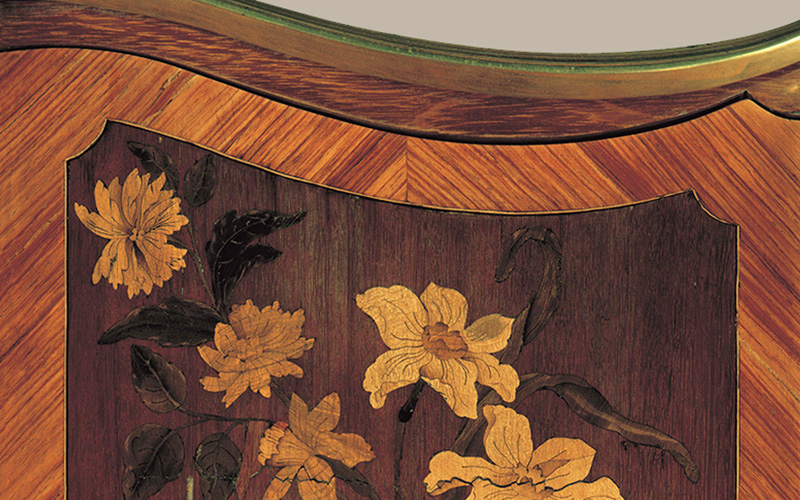
Jean-François Oeben. Mechanical table (detail). Paris, c. 176. Oak, elm, limewood and exotic woods; gilt bronze, velvet, mirror. Founder’s Collection The artisans involved in furniture production were cabinet-makers and ébénistes. The first worked with solid wood, producing certain items of furniture such as chairs and sofas, among others, as well as engaging in all joinery work linked to architecture. The second, the ébenistes, created veneered furniture using mostly exotic woods. This type of furniture began to be produced in France in the 17th century, becoming more widespread in the 18th century.
Ébénisterie is the art of enhancing the structure of a piece of furniture veneering it in precious woods, porcelain, lacquer and other materials. This technique, or set of techniques, is used for purely aesthetic purposes – veneer and marquetry are techniques used by the ébéniste. It originated in late medieval Italian art but attained an unprecedented degree of excellency in the 17th and 18th century in particular.
-
-
Gilt Bronzes

View of the exhibition. Photo © Pedro Pina 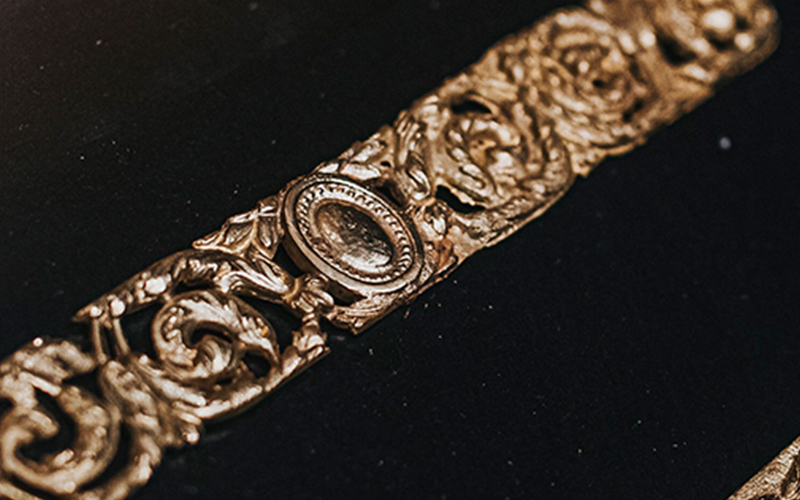
View of the exhibition. Photo © Pedro Pina 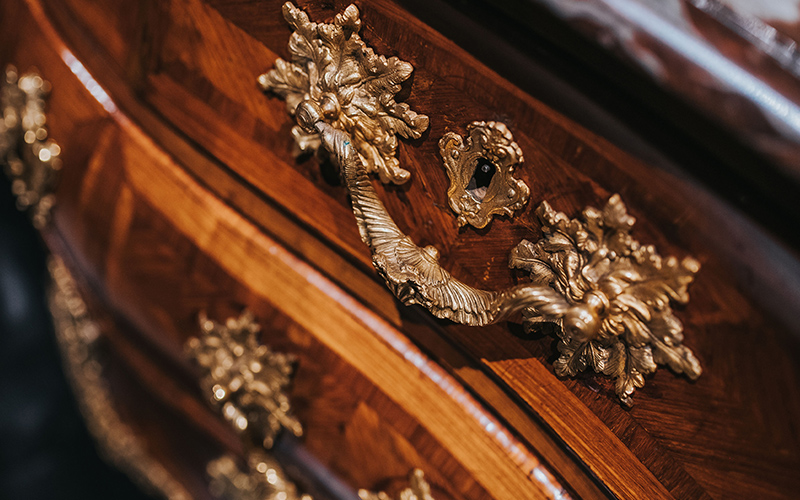
View of the exhibition. Photo © Pedro Pina The harmony between chiselled and gilt bronzes and high-quality marquetry took furniture of the time to a new level. The process involves a series of artisans. Firstly, the sculptor produces a mould of the piece from wood. This mould is used to create the shape in boxes filled with sand, into which the molten metal is poured. It must then be chiselled, acquiring its final form during this phase. The extremely precise work of the chiseller is key to the process, giving soul to the piece. Finally, it is gilded using the mercury method (ormolu).
-
-
An 18th-Century Workshop
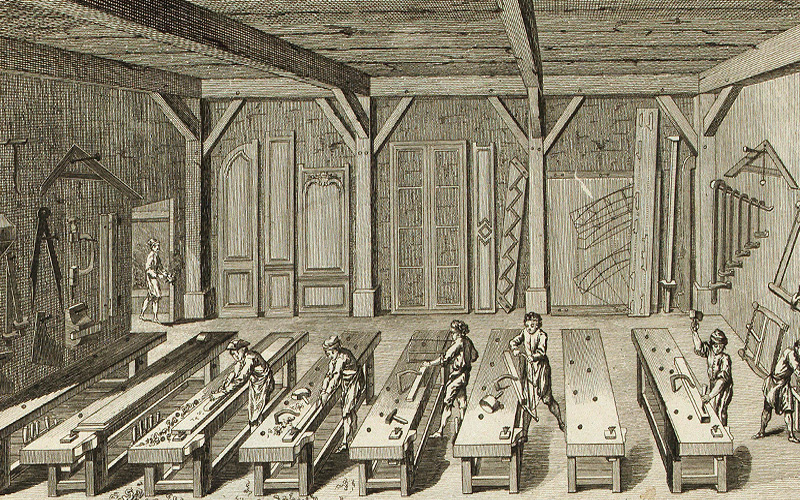
André-Jacob Roubo. L’Art du Menuisier en Meubles (detail). Paris, 1769– 1775. Founder’s Collection 
View of the exhibition. Photo © Pedro Pina 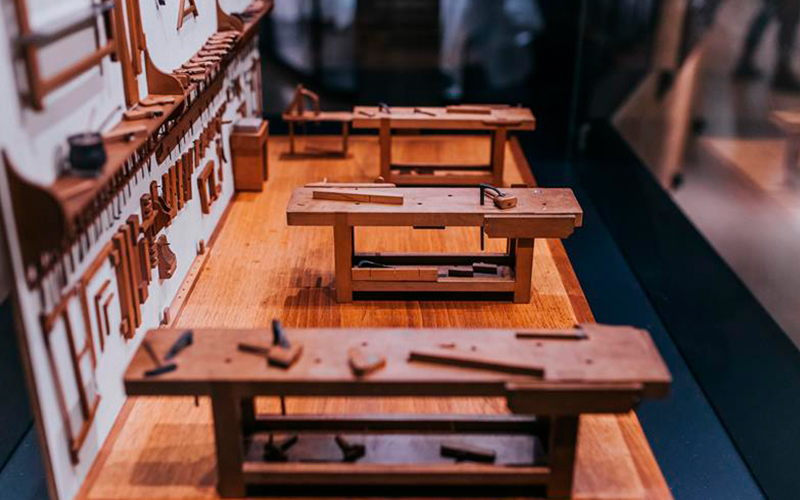
View of the exhibition. Photo © Pedro Pina A detailed model of an 18th-century cabinet-maker workshop, loaned by the Musée des Arts et Métiers in Paris, is shown in the exhibition. The level of detail allows us to see the tools used, the different elements used in the construction of a piece of furniture and the distribution of the work space.
-
-
18th- Century Furniture

Martin Calin. Charles-Nicolas Dodin. Writing table (detail). Paris, c. 1772. Carcass in oak; veneer and marquetry in sycamore, bois satiné, ebony and boxwood; Sèvres porcelain plaques; chased gild bronze mounts; velvet. Founder’s Collection 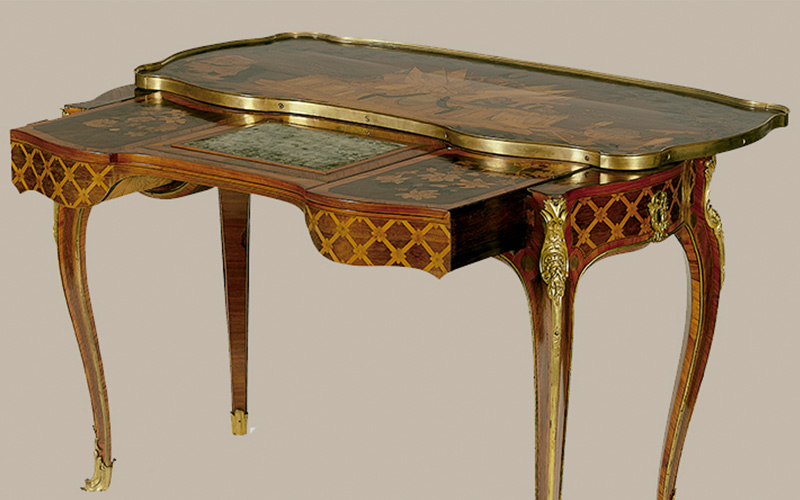
Jean-François Oeben. Mechanical table (detail). Paris, c. 176. Oak, elm, limewood and exotic woods; gilt bronze, velvet, mirror. Founder’s Collection 
Jean-Henri Riesener. Rolltop desk. Paris, 1773. Carcass in oak, marquetry in sycamore, amaranth, ebony, satinwood and other exotic woods; chased gilt bronze mounts; velvet. Founder’s Collection The 18th century was a time of great creativity. A number of innovative developments in luxury furniture production were introduced, such as furniture veneer in porcelain plaques or lacquer panels. Many existing types of furniture were reinvented during this period. Different kinds of tables, dressers and desks emerged. The bonheur du jour, a small desk used by women, was created at this time. Elegant, functional and intimate, this piece fulfilled all the requirements of modern life.
Another important invention during this century was mechanical furniture. In an era marked by growing links to scientific knowledge and experimentation, progress in watchmaking and the production of automata enabled the development of this kind of furniture.
The rolltop desk produced by Jean-Henri Riesener for the apartments of the Countess of Provence, the sister-in-law of Louis XVI, at Versailles, is an example of this kind of furniture.
-
Complementary Programs
Guided tour
Saturday, 12, 19 September, 15:00
Saturday, 19 September, 11:00
Talk with the curator Clara Serra
Beauty and expertise of 18th– century French furniture (in Portuguese only)
Saturday, 26 September, 16:00
Vida e obra. Uma visão da vida dos ebanistas parisienses do século XVIII
Com Helen Jacobsen, conservadora das Artes Decorativas francesas do século XVIII – The Wallace Collection, Londres.
Quinta, 3 setembro, 18:00
Saber mais
Life and work. An insight into lives of 18th– century Parisian cabinetmakers
With Helen Jacobsen (curator of French 18th– century Decorative Arts – The Wallace Collection, London)
Thursday, 3 September, 18:00
know more
Partnership
